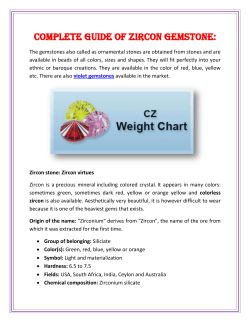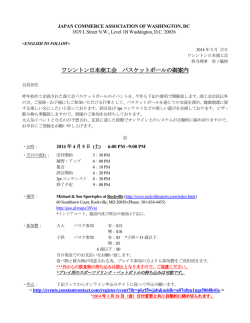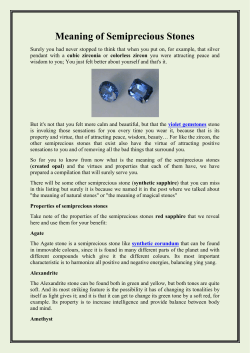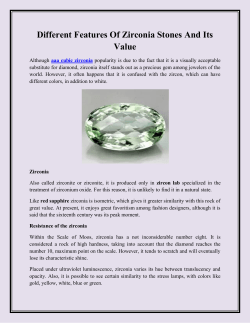
東南極セール・ロンダーネ山地パーレバンデにおける塩素に富む H2O
東南極セール・ロンダーネ山地パーレバンデにおける塩素に富む H2O 流体活動のタイミング 河上哲生 1、東野文子 1,2、ジェフリー・グランサム 3、石川正弘 4、土屋範芳 5、サティシュ・クマール 6、坂田周平 1 、エティエン・スクリペク 1、平田岳史 1、高塚紘太 1 1 2 京都大学、 日本学術振興会特別研究員 DC1、3 南アフリカ地質調査所、4 横浜国立大学、5 東北大学、6 新潟大学 Timing of Cl-rich aqueous fluid activity in Perlebandet, Sør Rondane Mountains, East Antarctica 3 4 5 Tetsuo Kawakami1, Fumiko Higashino1,2, Geoffrey H. Grantham , Masahiro Ishikawa , Noriyoshi Tsuchiya , M. Satish6 1 1 1 Kumar , Shuhei Sakata , Etienne Skrzypek , Takafumi Hirata , and Kota Takatsuka 1 1 Kyoto University, 2JSPS Research Fellow 3Council for Geoscience, South Africa, 4Yokohama National University, 5Tohoku University, 6Niigata University In situ LA-ICPMS U-Pb dating of zircon from Perlebandet, Sør Rondane Mountains (SRM), East Antarctica has been carried out in order to determine the timing of Cl-rich aqueous fluid or melt activity reported by Higashino et al. (2013). The Cl-rich aqueous fluid activity in the SRM is preserved as Cl-rich biotite and hornblende either as inclusions in garnet or as matrix minerals, and is reported to be distributed somewhat linearly from Balchenfjella through Brattnipene to Perlebandet (Higashino et al., 2013; under review). The Cl-rich aqueous fluid activity in Balchenfjella was dated to be ca. 600 Ma during the retrograde metamorphism at ca. 8 kbar, ca. 800oC (Higashino et al., 2013). The cation accompanying the Cl-rich aqueous fluid were determined to be Na and K in the example from Brattnipene and therefore, the fluid is considered to be highly saline brine in this case. In order to check the extent and timing of these Cl-rich aqueous fluid acticities in the SRM, it is important to constrain precise age of them in each locality. In previous studies, SHRIMP U-Pb zircon dating of a sillimanite-garnet-biotite gneiss from Perlebandet gave a inherited core age of 1009 ± 13 Ma, and metamorphic ages of ca. 750 Ma, ca. 610 Ma and ca. 560 Ma (Shiraishi et al., 2008). Sillimanite is the most common aluminosilicate mineral found in Perlebandet, but retrograde andalusite and relic kyanite are also present (Kawakami et al., 2010). From the presence of andalusite-bearing mineral assemblages replacing garnet, as well as the development of fine sillimanite needles at the grain boundaries of minerals, Kawakami et al. (2010) proposed contact metamorphism by a hidden pluton beneath this area. Extremely high magnetic anomalies observed beneath Perlebandet might indicate an asthenospheric mantle upwelling and magmatic underplating in this area (Osanai et al., 2013). Otsuji et al. (2013) reports low Sr isotope ratios and lower oxygen isotope ratios from Perlebandet metacarbonates, which are normally difficult to generate in continental settings, and support possible magmatic input from the mantle. Since a complex thermal- and fluidactivity history is inferred in Perlebandet, detailed in situ age determination correlating microstructures and age are required. The samples used in this study are two garnet-biotite gneisses (samples TK2009113001B & TK2009112601C) and one garnet-sillimanite-biotite gneiss (sample TK2009113001G) collected during the summer season of JARE51 (Tsuchiya et al., 2012). Samples TK2009113001B and G are from the nearby outcrops (71o50.638’S, 22o50.154’E and 71o50.663’S, 22o49.791’E, respectively), and sample TK2009112601C is from the northernmost part of Perlebandet (71o51.46’S, 22o47.518’E). Sample TK2009113001G contains three aluminosilicate polymorphs. Sillimanite porphyroblasts (up to 1 cm in diameter) show subgrains possibly formed by phase transformation of kyanite to sillimanite. Garnet is replaced by the andalusite-bearing, hydrous and retrograde mineral assemblages (Kawakami et al., 2010). This sample preserves evidence of a Cl-rich aqueous fluid activity both in garnet porphyroblasts and in the matrix as Cl-rich biotite. Matrix biotite is moderately Cl-bearing, suggesting later re-equilibrium of Cl-poorer fluids with the matrix biotite. Biotite replacing garnet and coexisting with andalusite show low Cl content, suggesting the Cl-poor fluid infiltration during andalusite formation. Zircon in the matrix showed U-Pb concordant ages of ca. 1100 Ma, 950-900 Ma, ca. 700 Ma and 650-580 Ma. The youngest zircon included in garnet was ca. 580 Ma, and that included in sillimanite was ca. 575 Ma. The youngest zircon found in the andalusite-bearing replacement of garnet (with Cl-poor biotite) is ca. 570 Ma. These 580-570 Ma zircons all show low Th/U ratio below 0.2. These observations imply that the contact metamorphism occurred soon after garnet growth at ca. 570 Ma. Garnet-forming metamorphism is interpreted to be older than ca. 580 Ma, and Cl-rich biotite formation (i.e., Cl-rich aqueous fluid activity) coincides with this timing. Sample TK2009113001B preserves evidence of Cl-rich aqueous fluid activity in the matrix as well as in the garnet inclusions as Cl-rich biotites (Cl up to 0.34 wt% in inclusion biotite and up to 0.25 wt% in matrix biotite). Zircon in the matrix showed U-Pb concordant ages of 850-750 Ma (with a peak at 785 ± 6 Ma), ca. 700 Ma, and ca. 630-550 Ma (with a peak at 599 ± 5 Ma). Zircon included in garnet gave an age of 596 ± 8 Ma, with the youngest grain giving an age of 585 ± 20 Ma. Zircon domains with ca. 600 Ma age are observed as bright CL rim, and show high Th/U ratio up to 1.6. Zircon with such microstructures are present in the matrix as well as inclusions in garnet. Judging from the high Th/U ratio of the zircon, these domains may represent growth during igneous activity. A low Th/U mantle with ca. 600 Ma age is also present, so metamorphism is likely associated with this igneous activity. The first Cl-rich aqueous fluid activity recorded by Cl-rich biotite inclusions in garnet took place by 585 ± 20 Ma. Moderately Cl-bearing (~ 0.2 wt% Cl) biotite in the matrix partly replaces garnet rim. Therefore, it is likely that the second Cl-rich aqueous fluid activity took place during the retrograde metamorphism, possibly by ca. 550 Ma. Sample TK2009112601C preserves evidence of Cl-rich aqueous fluid activity locally in the matrix as Cl-rich biotite (< 0.61 wt%Cl). The highest Cl content is observed in separate biotite grains in the matrix, and moderate Cl contents (< 0.37 wt%Cl) are observed in biotite replacing garnet rim as a biotite-plagioclase intergrowth. Garnet locally includes nano-granite-like polyphase inclusions. Zircon in the matrix and inclusion in garnet both showed U-Pb concordant ages of ca. 600-550 Ma (with a peak at 586 ± 5 Ma for matrix zircon and ca. 583 ± 6 Ma for inclusion in garnet). In addition to this, matrix zircon also shows ca. 680 Ma and 640-620 Ma ages. Th/U ratios of zircon with 600-550 Ma age are mostly below 0.4. Based on these results, the timing of Cl-rich aqueous fluid activity is likely during the period of the youngest zircon formation stage in the matrix, i.e., ca. 600-550 Ma. From the results above, the first Cl-rich aqueous fluid activity in Perlebandet preserved as the Cl-rich biotite inclusions in garnet took place before ca. 580 Ma, followed by the second, Cl-rich aqueous fluid activity recorded as the Cl-rich biotite in the matrix, which took place by ca. 550 Ma. Contact metamorphism under andalusite stability field caused by the hidden intrusion beneath Perlebandet was likely accompanied by Cl-poor aqueous fluid activity, because biotite coexisting with andalusite is Cl-poor. References Higashino, F., Kawakami, T., Satish-Kumar, M., Ishikawa, M., Maki, K., Tsuchiya, N., Grantham, G. H., Hirata, T. 2013. Chlorine-rich fluid or melt activity during granulite facies metamorphism in the Late Proterozoic to Cambrian continental collision zone- An example from the Sør Rondane Mountains, East Antarctica. Precambrian Research 234, 229-246. Higashino, F., Kawakami, T., Tsuchiya, N., Ishikawa, M., Grantham, G. H., Satish-Kumar, M., Multi-stage brine activity during amphibolite to granulite facies metamorphism in a continental collision zone –An example from the Sør Rondane Mountains, East Antarctica, Contributions to Mineralogy and Petrology, under review. Kawakami, T., Satish-Kumar, M., Tsuchiya, N., Ishikawa, M., Higashino, F., Grantham, G. H., Yoshida, K. 2010, Pelitic metamorphic rocks from Perlebandet and Balchenfjella, Sør Rondane Mountains, East Antarctica. Abstract of the NIPR science symposium. Osanai, Y., Nogi, Y., Baba, S., Nakano, N., Adachi, T., Hokada, T., Toyoshima, T., Owada, M., Satish-Kumar, M., Kamei, A., Kitano, I., 2013. Geologic evolution of the Sør Rondane Mountains, East Antarctica: Collision tectonics proposed based on metamorphic processes and magnetic anomalies. Precambrian Research, 234, 8-29. Otsuji, N., Satish-Kumar, M., Kamei, A., Tsuchiya, N., Kawakami, T., Ishikawa, M., Grantham, G. H., 2013. Late-Tonian to early-Cryogenian apparent depositional ages for metacarbonate rocks from the Sør Rondane Mountains, East Antarctica. Precambrian Research 234, 257-278. Shiraishi, K., Dunkley, D. J., Hokada, T., Fanning, C. M., Kagami, H., Hamamoto, T., 2008. Geochronological constrains on the Late Proterozoic to Cambrian crustal evolution of eastern Dronning Maud Land, East Antarctica: a synthesis of SHRIMP U-Pb age and Nd model age data. In: Satish-Kumar, M., Motoyoshi, Y., Osanai, Y., Hiroi, Y., Shiraishi, K. (Eds.), Geodynamic Evolution of East Antarctica: A Key to the East-West Gondwana Connection, Geological Society of London, Special Publications, 308, pp. 21–67. Tsuchiya, N., Ishikawa, M., Satish-Kumar, M., Kawakami, T., Kojima, H., Kaiden, H., Miura, H., Suganuma, Y., Abe, M., Sasaki, D., Chiba, M., Okada, Y., Hashizume, F., Grantham, G., Goderis, S., 2012. Report on geological fieldwork in the Sør Rondane Mountains, Eastern Dronning Maud Land, 2009–2010 (JARE-51). Antarctic Record 56, 295–379.
© Copyright 2024





